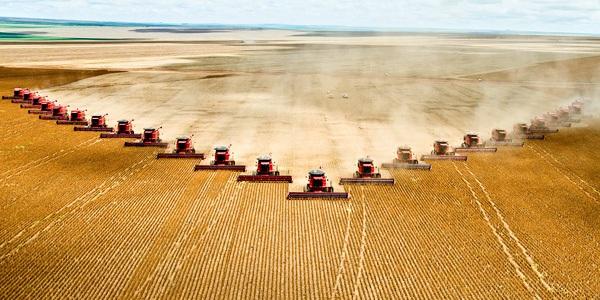
Soy milk sales have sharply declined in recent years, largely because of the almond industry’s nimble marketing campaigns, as well as exaggerated fears over soy’s effects on human health and the global soy industry’s impact on the environment. On that last point, the soy used to produce food products is not the much-feared GMO soy grown on industrial farms — if it were, the likes of Silk and its competitors would not have any business. Soy products could always rebound; Coca-Cola, in fact, recently purchased Argentina-based AdeS, a leading Latin American manufacturer of soy beverages.
But the soy industry’s expansion is of concern to many organizations, including WWF, since the vast majority of soy is used for animal feed. This trend will surely continue as the world demands, and can afford, more sources of protein. The world's soy farming is now centered in South America, and lax oversight in nations such as Brazil and Argentina have caused a host of problems, including environmental degradation, wildlife destruction and human rights violations. The global demand for soy has transformed -- or, according to many organizations including WWF, destroyed -- regions once rich in biodiversity, such as Brazil’s tropical cerrado.
To that end, this week WWF released its most recent soy scorecard, and based on this NGO's analysis, companies have a lot of work to do if they truly want to improve their sustainability performance.
WWF’s study focused on companies across nine nations in Europe. Analysts evaluated companies’ total soy consumption versus the percentage of responsible soy used, as well as publicly disclosed commitments to source responsible soy and take steps to cease deforestation. The study was segmented by four sectors: dairy and processed food manufacturers; retail and food service companies; meat and egg producers; and, most importantly, feed companies.
The results were not encouraging for many of Europe’s leading brands, particularly companies that insist they have a strong reputation for sustainable business practices. A few companies, including Denmark’s Arla Foods and Skanemejerier of Sweden, scored highly, largely since these firms say they procure 100 percent sustainable soy certified from organizations such as the Roundtable for Responsible Soy and the ProTerra Foundation. Other companies, including Unilever (of which sustainably-sourced soy is only 8 percent of its total soy consumption) and Danone (any soy-related goals are not set until 2020), were given tepid marks. Nestlé, which has long touted its sustainability credentials, did not respond.
Retailers tended to perform better than food manufacturers. The Dutch companies Albert Heijn and Jumbo were included among those leading the pack, while British retailers such as Marks & Spencer and Waitrose are transitioning to 100 percent responsibly-sourced soy products. Hypermarket giants such as Carrefour and Tesco are trailing in WWF’s eyes, while Ikea is one example of a retailer ignoring the survey entirely.
What is most troubling, however, is from whom these aforementioned companies source their soy in the first place. According to WWF, the animal feed sector buys 75 percent of the soy produced across the world. But the lack of transparency is endemic throughout this industry. Sweden’s Lantmannen and Raisio Group of Finland are leaders, as judged by other organizations as well. Raisio, for example, claims that it applies its sustainable sourcing policies not only to soy, but also to other commodities including sugar and grains.
The WWF says that the average European eats the equivalent 134 pounds (61 kilograms) of soy a year, with the result that the demand for land to cultivate soy in order to sustain these global supply chains keeps surging. Therefore, it behooves companies to become more transparent about their soy sourcing policies. And at a time when companies are trying to prove that they are tackling their environmental impact and water consumption, addressing the problems behind soy cultivation will make huge strides in reducing these companies’ global footprint.
Image credit: Lou Gould/Flickr

Leon Kaye has written for 3p since 2010 and become executive editor in 2018. His previous work includes writing for the Guardian as well as other online and print publications. In addition, he's worked in sales executive roles within technology and financial research companies, as well as for a public relations firm, for which he consulted with one of the globe’s leading sustainability initiatives. Currently living in Central California, he’s traveled to 70-plus countries and has lived and worked in South Korea, the United Arab Emirates and Uruguay.
Leon’s an alum of Fresno State, the University of Maryland, Baltimore County and the University of Southern California's Marshall Business School. He enjoys traveling abroad as well as exploring California’s Central Coast and the Sierra Nevadas.














